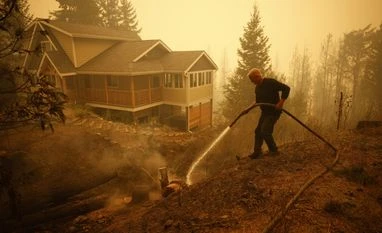A fast-moving wildfire burning through the Texas Panhandle grew into the second-largest blaze in state history on Wednesday, forcing evacuations and triggering power outages as firefighters struggled to contain the widening flames.
The sprawling blaze was part of a cluster of fires that burned out of control and threatened rural towns, where local officials shut down roads and urged residents to leave their homes.
The largest of the fires which grew to nearly 800 square miles (2,072 square kilometers) jumped into parts of neighbouring Oklahoma and was completely uncontained as dawn broke, according to the Texas A and M Forest Service.
Officials were assessing the damage on Wednesday and warned it could be extensive. Hemphill County Emergency Management Coordinator Bill Kendall described the charred terrain like a moonscape. ... It's just all gone.
Kendall said about 40 homes were burned around the perimeter of the town of Canadian, but no buildings were lost inside the community.
We started getting those losses in the dark, so we didn't really know what we had until this morning, until we could see, he said.
More From This Section
The town of Fritch, with a population of less than 2,000, lost hundreds of homes in a 2014 fire and appeared to be hit hard again.
The people in that area are probably not "prepared for what they're going to see if they pull into town, Hutchinson County Emergency Management spokesperson Deidra Thomas said in a social media livestream. She compared the damage to a tornado.
The town remained unsafe for people to return, she said.
Authorities have not said what ignited the fires, but strong winds, dry grass and unseasonably warm temperatures fed the blazes. Near Borger, a community of about 13,000 people, emergency officials at one point late Tuesday answered questions from panicked residents during a Facebook livestream and told them to get ready to leave if they had not already.
It was like a ring of fire around Borger. There was no way out ... all four main roads were closed, said Adrianna Hill, 28, whose home was within about a mile of the fire. She said a northern wind that blew the fire in the opposite direction saved our butts.
Republican Gov. Greg Abbott issued a disaster declaration for 60 counties. The encroaching flames caused the main facility that disassembles America's nuclear arsenal to pause operations on Tuesday night, but it was open for normal work on Wednesday.
The blazes tore through sparsely populated counties on the vast, high plains that are punctuated by cattle ranches and oil rigs. The main fire, known as the Smoke House Creek Fire, had grown to more than half the size of the state of Rhode Island. It is five times larger than on Monday, when it began.
The weather forecast provided some hope for firefighters cooler temperatures, less wind and possibly rain on Thursday. But for now, the situation was dire in some areas.
Sustained winds of up to 45 mph (72 kph), with gusts of up to 70 mph (113 kph), caused the fires that were spreading east to turn south, threatening new areas, forecasters said. But winds calmed down after a cold front came through Tuesday evening, said Peter Vanden Bosch, a meteorologist at the National Weather Service in Amarillo, Texas.
Fortunately, the winds have weakened quite significantly, Vanden Bosch said Wednesday. Breezy conditions were expected again Friday, and critical fire weather could return by the weekend, he said.
As the evacuation orders mounted on Tuesday, county and city officials implored residents to turn on emergency alert services on their cellphones and be ready to evacuate immediately.
An unknown number of homes and other structures in the county were damaged or destroyed, local emergency officials said.
The Pantex plant, northeast of Amarillo, evacuated nonessential staff Tuesday night out of an abundance of caution, said Laef Pendergraft, a spokesperson for National Nuclear Security Administration's production office at Pantex. Firefighters remained in case of an emergency.
The plant has long been the main US site for both assembling and disassembling atomic bombs. It completed its last new bomb in 1991 and has dismantled thousands since.
Pantex tweeted early on Wednesday that the facility is open for normal day shift operations and that all personnel were to report for duty according to their assigned schedule.
As the fires raged on Tuesday, evacuations were ordered in several towns in a swath northeast of Amarillo.
The Smokehouse Creek Fire spread from Texas into neighbouring Roger Mills County in western Oklahoma, where officials encouraged people in the Durham area to flee. Officials did not know yet how large the fire was in Oklahoma. The Roger Mills County emergency management director did not immediately return phone calls for comment.
An unrelated fire in Ellis County, Oklahoma, on the Oklahoma-Texas state line, led Tuesday to the evacuations of the towns of Shattuck and Gage. The evacuation order was lifted hours later, according to county Emergency Management Director Riley Latta. The fire had unknown origins and burned an estimated 47 square miles, according to the Oklahoma Department of Agriculture, Food and Forestry.
On Tuesday evening, the fires were 20 to 25 miles (32 to 40 kilometers) from Amarillo, and wind was blowing smoke into the city, which could affect people with respiratory issues, National Weather Service officials said.
The weather service issued red-flag warnings and fire-danger alerts for several other states through the midsection of the country, as winds of over 40 mph (64 kph) combined with warm temperatures, low humidity and dry winter vegetation to make conditions ripe for wildfires.
In central Nebraska, a mower sparked a prairie fire that burned a huge swath of grassland roughly the size of the state's largest city of Omaha, state officials said on Tuesday.
)